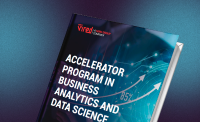In machine learning, ensuring that a model fits “just right” is a fascinating challenge. Think of it like Goldilocks searching for the perfect-fitting chair.
More complexity, called overfitting, and the model might get too snug with the training data, struggling to handle new information.
More complexity is termed underfitting, and it might need to grasp the training data properly. Striking that ideal balance is like finding the “just right” chair – a model generalizing well for accurate predictions beyond its training experience.
In the section below, we’ll discuss about overfitting and underfitting in machine learning.
So, let’s get started.
Basics of Overfitting and Underfitting
Underfitting: This is like having a very simple-minded program. It doesn’t really learn the details from the pictures, so it could be better at recognizing even the animals it has seen before.
It’s like teaching a little kid about animals by just showing them blurry sketches. They won’t be able to tell a dog from a cat because the sketches are too vague.
Overfitting: Overfitting is like teaching that computer program to remember every picture in your training set so perfectly that it starts to think every tiny detail is essential.
If you’re teaching it about dogs, it might start recognizing only those particular dogs in the training pictures and won’t recognize any other dogs that look slightly different.
Check out here the Accelerator Program in Business Analytics and Data Science.


Get curriculum highlights, career paths, industry insights and accelerate your data science journey.
Download brochure
Causes of Over Fitting
Model Complexity
Imagine a super intricate puzzle that matches every piece perfectly, but only for that one puzzle. Similarly, complex models can memorize examples instead of understanding the bigger picture.
Insufficient Data
Picture learning to cook from just one recipe. You’d need to take advantage of different flavors. With few examples, a model guesses rather than learns, like deciding all desserts taste like chocolate cake.
Noise in Data
Think of static in a phone call distorting words. Models can also misunderstand random bumps in data as important things, making it like hearing words that weren’t really said.
Lack of Regularization
Imagine a kid practicing piano without guidance and hitting all the wrong notes. Regularization guides models, preventing them from getting lost in details and playing smoother tunes.
Causes of Underfitting
Model Simplicity
Imagine trying to describe a whole movie plot using just a single sentence. Overly simple models need to be included in the rich details and complex twists in the data.
Inadequate Features
Think of baking a cake without key ingredients – it won’t taste right. Models need the right “ingredients” (features) to understand data properly; missing ones lead to confusion.
Insufficient Training
It’s like giving up on learning after reading just one book page. Models need enough examples to grasp the full story, so not giving them enough data makes them clueless.
Model Selection
Choosing the right model is like picking the right tool for a job. If your model is like a hammer when you need a screwdriver, it won’t work well. Picking the right tool (model) is key.
Preventing Overfitting
Cross-validation
Imagine you’re practicing for a big performance but want to make sure you’re good. So, you don’t just practice once – you practice many times and swap roles with your friend each time to judge each other. This is like cross-validation for models.
It tests how well your model will perform on new data by trying it out on different parts of your training data. It helps you see if your model is truly prepared for the big show (or real-world data).
Regularization
Think of teaching a robot to dance. If it copies every move perfectly, it might get stuck and not dance smoothly. Regularization is like teaching the robot to dance while also allowing some small, wiggly mistakes.
It stops the model from getting overly attached to every tiny piece of data, making it more flexible and better at dancing with new moves.
Early stopping
Imagine training a dog to fetch. If you repeatedly throw the ball, the dog might get tired or lose interest. Early stopping is like recognizing when your model is tired of learning from the data.
You stop the training when the model starts making more mistakes on new data, so it only learns a little from the old stuff.
Dropout
Think of a choir practice where some singers randomly take breaks. It forces the other singers to be more independent and flexible, as they can only sometimes rely on the missing voices. Dropout does something similar with models.
It randomly “turns off” some parts of the model during training, forcing the rest to work harder and learn more independently. This helps prevent the model from becoming too attached to specific features and keeps it more versatile.
Click here to learn about Big Data Analytics: What It Is, How It Works?
Addressing Underfitting
Feature Engineering
Imagine you’re telling a story, but you realize you’re missing some crucial details. Feature engineering is like adding those missing bits to your story.
It means coming up with new and smarter ways to describe your data for models. It’s like telling your model more interesting things about the animals in pictures so it can understand them better.
Model Selection
Choosing a model is like picking the right tool for a job. If you’re building a car, you won’t use a hammer. Similarly, for your data, you need the right model that matches its complexity. If your data is like a jigsaw puzzle, you’d pick a good model to assemble those pieces.
Increasing Training Data
Imagine you’re learning to ride a bike. The more you practice, the better you get. It’s the same with models. More data means more practice for the model. If you’re teaching it to recognize animals, having many pictures of different animals helps it learn the common patterns better.
Fine-Tuning Hyperparameters
Think of tuning a guitar. The sound is off if the strings are too tight or loose. Hyperparameters are like those strings – they control how the model learns.
By fine-tuning them, you’re adjusting the learning process to make sure the model’s performance is just right. It’s like getting the guitar strings to the perfect tension for the best sound.

Conclusion
In machine learning, finding the right balance between overfitting and underfitting is like walking a tightrope. Overfitting, akin to memorizing instead of learning, can lead to poor generalization.
Underfitting, like oversimplification, results in missing the bigger picture.
The key is striking the perfect balance through cross-validation, regularization, and thoughtful model selection.
FAQs
Overfitting is like memorizing, missing the point. Underfitting needs to be more complex, with more details. Striking balance means learning the right amount without getting too stuck or too vague.
Identify overfitting by great training but poor new data performance. Spot underfitting with poor results on both. Find a sweet spot when the model performs well on unseen data.
Overfitting comes from overly complex models fitting noise. Underfitting stems from overly simple models missing patterns. Both need the right balance for good predictions on new data.
For overfitting, simplify models, add more data, use regularization techniques, and monitor performance on new data. For underfitting, increase model complexity, feature richness, and training data.
To reduce overfitting, use simpler models, gather more diverse data, employ regularization methods, validate with new data, and consider techniques like dropout and early stopping.










